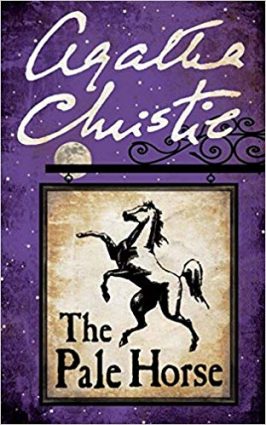 A list of names and a startling secret is given to Father Gorman by a dying woman. Her claims are terrible – but before they can be acted on, Gorman is killed in the street.
A list of names and a startling secret is given to Father Gorman by a dying woman. Her claims are terrible – but before they can be acted on, Gorman is killed in the street.
Meanwhile, Mark Easterbrook, a historian learns of The Pale Horse, a former inn in the village of Much Deeping where three apparent witches arrange for people to die while the mysterious invalided Mr Venables lurks in the shadows. Mysterious indeed – for while Venables is apparently invalided, a reliable witness swears that it was him who walked up to Father Gorman and murdered him? More evidence of witchcraft – or is an earthly hand behind things?
I decided to take another look at this one before I watch the new BBC version of it – after all, based on previous adaptations, I thought I’d save the best version for first. I’ve read it before, but couldn’t remember much about it and decided I didn’t want the ending spoiled by the TV adaptation. I’m going into it with an open mind – I’ve watched the first episode already and it’s not awful – but let’s face it, no adaptation has ever improved on Christie’s original, has it?
You might recall that this was voted the third best non-series/non-ten-people-on-an-island Christie novel in the definitive Agatha Christie poll, so I was looking forward to re-reading it. I was fairly sure I enjoyed it the first time – but I had more reservations this time round.
First of all, as a whodunit, it’s really disappointing, especially coming from Christie. There’s a dearth of suspects – at least ones that are clearly aren’t guilty due to being too suspicious – and the misdirection that makes you look away from the prime mover in the crimes is basically stupidity. It seems so unlikely that someone who could put together such a murderous scheme would do such a stupid thing, which is quite a lazy way of making you look the other way.
As a thriller though, it’s an entertaining read. Easterbrook is an interesting lead, despite not having the deepest character, and the ideas here are refreshing original. There are some fun supporting characters – Ariadne Oliver plays a role and I did enjoy the love interest, Ginger. There is some reflection on some of the fears of the day and while I doubt anyone would recognise the method going on here, there is a lovely clue early on that the reader is almost guaranteed to miss.
A strong late Christie title, and definitely worth your time – now I wonder what the adaptation is like?
Trivia: this book saved two lives and caught a murderer when symptoms such as in the book were recognised in real life.

Never made much if an impression on me as a book. Very curious to hear what you make of the TV version as I have have redisted warching not wishing to have another Sarah Phelps farrago rammed down my throat.
LikeLike
Sorry for the typos!!
LikeLike
I thot yu wuz mockin ‘er cockney characters hack-sents.
LikeLike
Unlike so many of her thrillers, this one was fun for me to read from start to finish. There’s the plot, which seems ridiculous until, as you mention, you find out real-life murderers have tried it for themselves. And there’s the mash-up of different Christie worlds, with Poirot and Marple characters co-existing. And I agree with you on two points: that early clue is smashingly brilliant: even though we might not recognize its significance, we should understand that something is very off and all is not right with the world; and I agree that the main villain’s mistake is so utterly stupid that it gives one pause – except, of course, as a kid I didn’t see it at all.
LikeLike
Long time reader, first time commenter.
My memory is a little vague on the plot mechanics of this one, but I remember being absolutely flummoxed by the end. And I came to this book a little later, in my 20’s after having read most of Christie as a teenager, hoping i had forgotten most of the plot or at least the whodunnits of the novels. This book renewed my love for her novels and whodunnits in general.
LikeLike
I think I was in a similar position when I read this first time through – I have the oddest memory of reading it while in the gym, an old habit that has long since departed. It was a return to Christie after not having read this one before and I really enjoyed it. This time round, the sheer stupidity of the killer on one point, given the cleverness of the scheme, really stood out for some reason.
LikeLike
[…] Horse has been reviewed, among others, at The Golden Age of Detection Wiki, Ah Sweet Mystery Blog, In Search of the Classic Mystery Novel, My Reader’s Block, Mysteries in Paradise, The Crime Segments, and The Grandest Game in the […]
LikeLike
Beyond the pivotal act of stupidity, I wasn’t sure how the killer was supposed to know about Father Gorman in the first place.
LikeLike
Read this so long ago, I forget. I’ll let you know my thoughts when/if I read it again
LikeLike